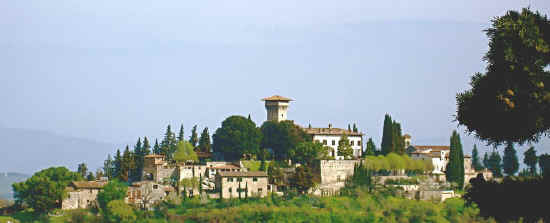|
"Chianti,
Tuscany" is the name of one of the most famous areas of Tuscany even though it is
now a wine
territory rather than a province or other political division of the region of Tuscany.
The Chianti
area of Tuscany is a hilly, roughly oval-shaped territory located in the
middle of the region delimited by the Etruscan towns of Arezzo,
Volterra and
Fiesole.
The history
of Chianti has been studied intensively and the extant towns,
villages, abbeys and towers of Chianti reflect that history. The
Etruscans dominated Chianti and the rest of Tuscany for several hundred
years and genetic evidence shows that their descendents and the
descendents of some of their domestic animals still inhabit the area.
Certainly they introduced wine production into Chianti. The
Romans displaced the Etruscans as the rulers of Chianti during the
first century AD. They expanded the Etruscan towns in many but not all
cases, and founded their own cities, most notably, Florence (Florentia).
Following the fall of the Western Roman Empire in the years around 376
AD, several centuries of barbarian incursions known as the "Italian Dark
Age" ensued. Little documentation from this period survives but it
was the period when many feudal castles and fortified villages were
founded by the various barbarian invaders, most notably the Longobards
(Lombards).
It was also the period when the first Christians evangelists were active
in Chianti. Numerous place names commemorate the early saints among
these evengelists - San Donato, San Cresci, San Michele, San Leolino,
San Eufrosino, San Miniato and so on. Also among their number were the precursors of the monastic orders of the Vallombrosans of
San Giovanni Gualberto and Romualdo di Camaldoli. It was these orders
that founded the great abbeys that one can admire
throughout Chianti to this day. Interestingly, many of the diocesan
boundaries of today are more Etruscan than Roman - the Diocese of
Fiesole being a famous example. The Dark Age lasted until about 1000 AD
from which point onwards, the archives provide a rich trove of
information on life in Tuscany.
The Dark Age (Early Middle Ages) were followed by the High Middle Ages (11 C, 12 C and 13 C) and the ascent of the
Tuscan city states, prominent among them being Florence, Pisa, Lucca and
Sienna. The Late Middle Ages (14 C and 15 C), characterised by a major increase in population, led up to the Italian
Renaissance which flowered above all in Florence and Sienna, at the
northern and southern tips of Chianti respectively. Not surprisingly,
the influence of the Renaissance is strongly evident in the style of the
numerous castles
of Chianti that were converted into archetypal "Tuscan
villas". However, Chianti has a rich vernacular
architecture manifested in its innumerable tower houses,
monasteries, abbeys, villas and walled hamlets. It is these latter,
combined with a landscape of highly cultivated vineyards and olive
groves, surrounded by dense forest that will catch the eye of a visitor
to Chianti, Italy.
|
